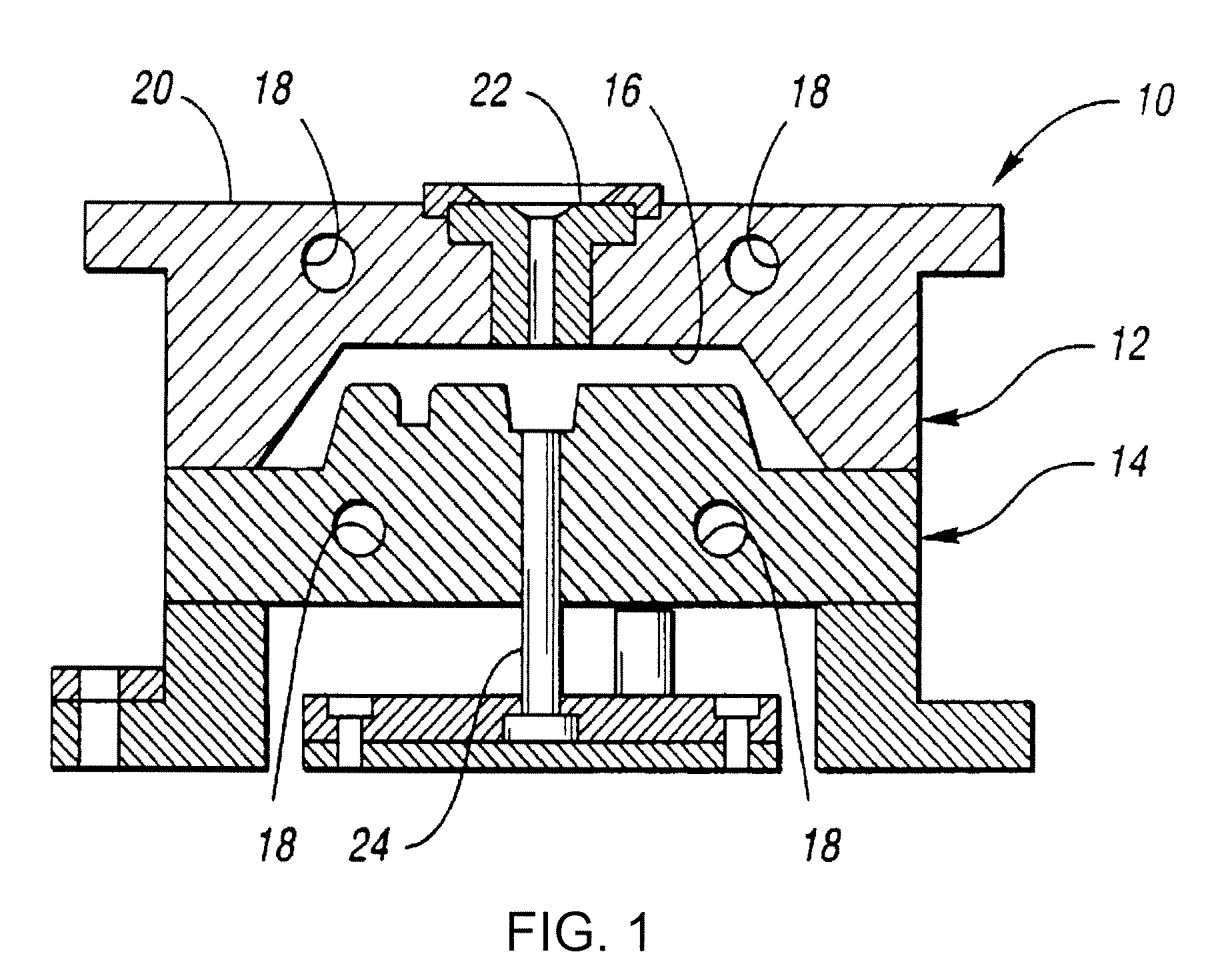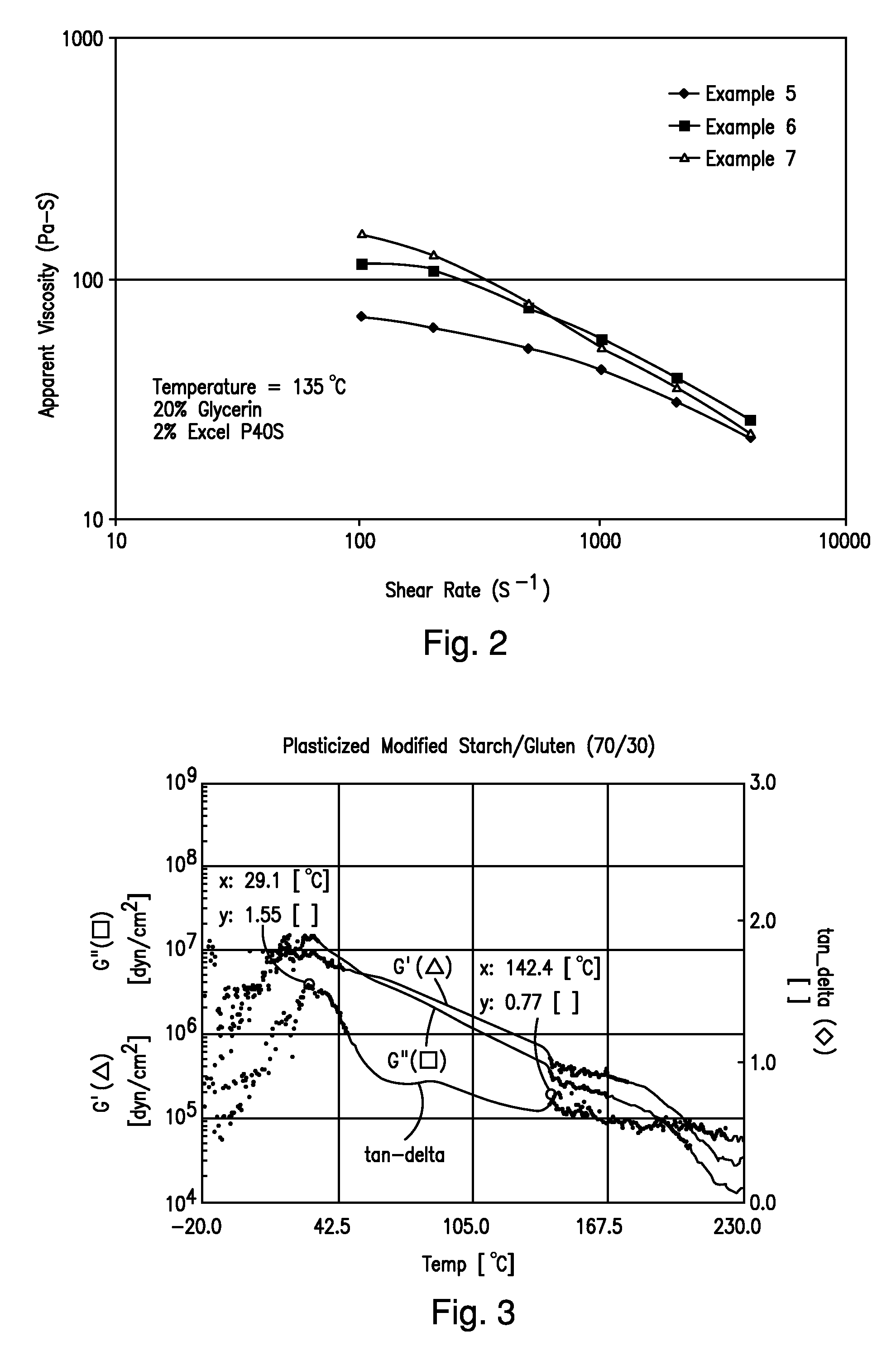Injection Molding Material Containing Starch and Plant Protein
a technology of injection molding material and starch, which is applied in the direction of synthetic resin layered products, domestic objects, woodworking apparatus, etc., can solve the problems of increasing the time and cost involved in molding operation, affecting the quality of injection molding, and often forming synthetic polymers
- Summary
- Abstract
- Description
- Claims
- Application Information
AI Technical Summary
Problems solved by technology
Method used
Image
Examples
example 1
[0039]100 wt. % Pro-Cote® 4200 (DuPont) was initially added to a K-Tron feeder (K-Tron America, Pitman, N.J.) that fed the materials into a ZSK-30 co-rotating, twin screw extruder (Werner and Pfleidere Corporation, Ramsey, N.J.). Pro-Cote® 4200 is a soy protein having a weight average molecular weight of about 150,000 to 200,000 Daltons. The extruder diameter was 30 mm and the length of the screws was up to 1328 mm. The extruder has 14 barrels, numbered consecutively 1 to 14 from the feed hopper to the die. The first barrel received the soy protein at a feed rate of 10 lbs / hr. The temperature profile of zones 1 to 14 of the extruder was 100-130° C. for each zone. The screw speed was set at 110 rpm to achieve a torque of 40%. The melt temperature was 123° C. Glycerin was pumped into barrel 5 with a pressurized injector connected with an Eldex pump (Napa, Calif.) at a rate of 24 grams per minute to achieve a 30 wt. % concentration. The vent was opened at the end of the extruder to rel...
example 2
[0040]A mixture of 80 wt. % GlucOSOITM 800 (Chemstar, Minneapolis, Minn.) and 20 wt. % Pro-Cote® 4200 (DuPont) was initially formed in a Hobart mixer. Glucosol™ 800 is a modified starch having a weight average molecular weight (determined by GPC) of 2,900,000; polydispersity index of about 28; bulk density of 30˜40 lbs / ft3, and D98 particle size of 140 mesh. The mixture was then added to a K-Tron feeder (K-Tron America, Pitman, N.J.) that fed the materials into a ZSK-30 co-rotating, twin screw extruder (Werner and Pfleidere Corporation, Ramsey, N.J.) as described in Example 1. The first barrel received the mixture at a feed rate of 10 lbs / hr. The temperature profile of zones 1 to 14 of the extruder was 90° C., 110° C., 125° C., 130° C., 130° C., 122° C., and 117° C. The screw speed was set at 150 rpm to achieve a torque of about 60%. The melt temperature was 128° C. to 130° C. Glycerin was pumped into barrel 5 with a pressurized injector connected with an Eldex pump (Napa, Calif.) a...
example 3
[0041]A mixture of 60 wt. % Glucosol™ 800 (Chemstar, Minneapolis, Minn.) and 40 wt. % Pro-Cote® 4200 (DuPont) was initially formed in a Hobart mixer and then added to a K-Tron feeder (K-Tron America, Pitman, N.J.) that fed the materials into a ZSK-30 co-rotating, twin screw extruder (Werner and Pfleidere Corporation, Ramsey, N.J.) as described in Example 1. The first barrel received the mixture at a feed rate of 10 lbs / hr. The temperature profile of zones 1 to 14 of the extruder was 90° C., 110° C., 118° C., 122° C., 122° C., 122° C., and 115° C., The screw speed was set at 150 rpm to achieve a torque of about 60% to 68%. The melt temperature was 124° C. to 127° C. Glycerin was pumped into barrel 5 with a pressurized injector connected with an Eldex pump (Napa, Calif.) at a rate of 24 grams per minute to achieve a 30 wt. % concentration. The vent was opened at the end of the extruder to release moisture. A die was employed to form strands that had 2 openings of 7 mm in diameter, whi...
PUM
| Property | Measurement | Unit |
|---|---|---|
| Density | aaaaa | aaaaa |
| Flexural modulus | aaaaa | aaaaa |
| Shrinkage | aaaaa | aaaaa |
Abstract
Description
Claims
Application Information
 Login to View More
Login to View More - R&D
- Intellectual Property
- Life Sciences
- Materials
- Tech Scout
- Unparalleled Data Quality
- Higher Quality Content
- 60% Fewer Hallucinations
Browse by: Latest US Patents, China's latest patents, Technical Efficacy Thesaurus, Application Domain, Technology Topic, Popular Technical Reports.
© 2025 PatSnap. All rights reserved.Legal|Privacy policy|Modern Slavery Act Transparency Statement|Sitemap|About US| Contact US: help@patsnap.com



